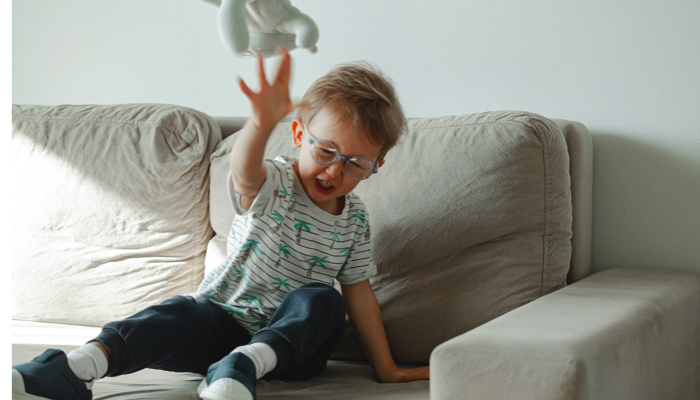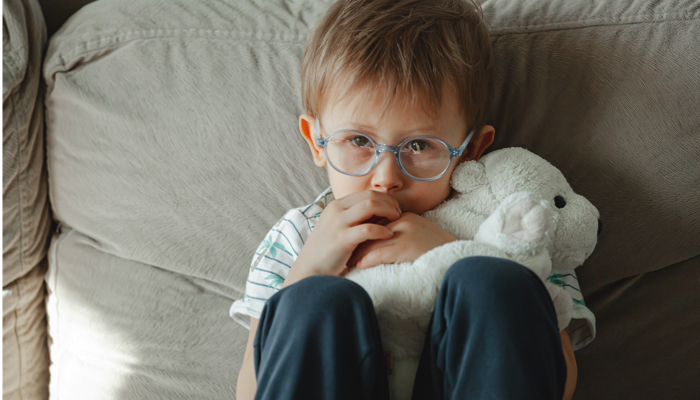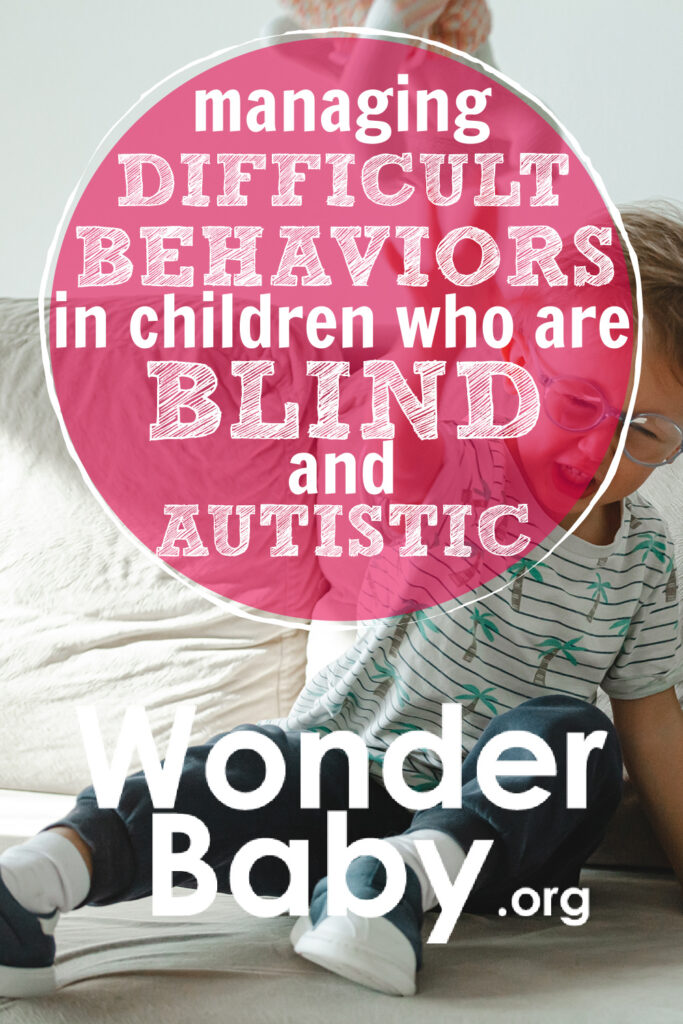Managing Difficult Behaviors in Children Who Are Blind and Autistic

Parents of children who are blind and autistic often face unique challenges when it comes to managing behavioral issues. Many traditional behavioral management techniques rely on visual supports, which can be ineffective or even counterproductive for a child who is blind. However, there are several strategies that can be effective with children who are blind and autistic.
I had the opportunity to talk to Mary Jane Weiss, PhD, BCBA-D, LABA, and Associate Dean of Applied Behavior Analysis at Endicott College. I asked her how we can diagnose autism in children who are blind and how we can better address and serve the needs of kids who are blind and autistic.
Assessing Autism in a Child Who Is Also Congenitally Blind
Autism spectrum disorder (ASD) isn’t diagnosed through a simple blood test but through developmental monitoring, screening, and evaluation. The CDC offers milestone and developmental checklists for parents to consult to ensure their kids are staying on track developmentally. If you or your child’s doctor suspect ASD, you can request a formal evaluation. Some signs to look for are:
- Challenging behaviors
- Not making eye contact
- Underdeveloped social skills
- Self-stimulation
- Repetitive behaviors
- Poor sleep habits
- Dependence on routines
- Delayed communication skills
- Sensory sensitivities
- Fear of loud noises
As the parent of a blind child, you may notice a problem here. A child who doesn’t make eye contact, has difficulties developing social skills, thrives on routine, self-stims, and dislikes loud noises? That could easily describe a child who is visually impaired!
Many families raising children who are blind will find themselves wondering about a possible autism diagnosis. According to a recent study in the Journal of Autism and Developmental Disorders, “At least one-third of all children with blindness have been reported to meet the diagnostic criteria for ASD,” with an increased likelihood for children diagnosed with optic nerve hypoplasia (ONH), retinopathy of prematurity (ROP), anophthalmia, and Leber’s congenital amaurosis (LCA).
Dr. Weiss stresses the importance of individualized assessments. After all, that is the point of an evaluation! She says, “I think that one of the most important things to remember about diagnosis is how individualized it is and how careful we have to be about the presence of any one characteristic being indicative of anything.”
When having your child evaluated for autism, find someone with experience working with blind children. A local school for the blind or your child’s ophthalmologist’s office should be able to point you in the right direction. It’s crucial for your child’s evaluator to understand that some behaviors associated with autism may also appear with other diagnoses as well.
Dr. Weiss points out that “an individual might be engaging in behaviors we commonly call self-stimulatory, such as flapping or other repetitive behaviors. This may be an indicator of autism, along with many other characteristics, but it may not be. Those behaviors occur in individuals who have autism and individuals who do not have autism, and certainly in individuals who may have other disabilities, including visual impairment.”
Why Autistic Children Might Display Difficult Behaviors
ASD is often associated with emotional and behavioral problems. If your child has autism, you may see them acting out, having meltdowns, self-harming, or becoming overwhelmed very easily. It’s difficult to address these problem behaviors if you don’t understand their origin.
Dr. Weiss appreciates that for parents “a child’s challenging behaviors often do seem to come out of nowhere, and it isn’t something you can easily gain an understanding of or control over, so you feel kind of helpless. I think one of the things that we’ve developed as a field over the last few decades is understanding why anyone engages in challenging behaviors.
“Autism experts used to focus much more on behavior modification. As professionals, we would see challenging behaviors and then work to reduce or eradicate them. Now the field of behavior analysis focuses much more on understanding behavior and understanding the unique reasons why a particular individual might be experiencing behavioral challenges.”
Two common sources of behavior problems are attention seeking and escape motivation. A child may act out in a classroom in order to gain the attention of the teacher, for example. In other instances, a child may act out because they want to avoid a particularly difficult situation or task. How we approach these behaviors would depend on the reason behind them.
“What we need to understand is how this particular behavior emerged for this individual as a coping strategy,” says Dr. Weiss. “Then we can look at how to creatively construct an environment where other alternatives are available for that individual. It’s important to remember that often the root of the problem is limited communication skills. We need to help children with autism convey to the adults in their lives what they’re experiencing and what they need. Augmentative and alternative communication devices (AAC) can be extremely helpful for children who exhibit problem behaviors.”

Creating a Behavior Support Plan for a Blind Child on the Spectrum: 4 Tips For Success
A Behavior Support Plan (BSP) is a personalized strategy that helps support healthy and positive responses in children who may be struggling with challenging behaviors. The BSP addresses difficulties a child is having in school or at home and outlines specific goals that have been tailored to meet those challenges.
Crafting an effective Behavior Support Plan is tricky. You want to be able to meet your child’s needs while also giving your child the space to grow and succeed. Below are Dr. Weiss’s four tips for creating a successful BSP:
1. Begin With a Comprehensive Assessment
All good plans begin with a strong assessment. It’s impossible to effectively address a problem without fully understanding what the problem is!
“I think it’s easy for any of us to overgeneralize from one example of a problem behavior and think we understand the full story,” admits Dr. Weiss. “But you really do need to do a comprehensive assessment and get a broad understanding of that individual’s behavior that enables you to have some confidence as a team in what might be experienced by that individual. That’s going to help you identify what you need to do to change the environment to make your child’s behavioral issues less likely.”
2. Build a Team of Experts
Dr. Weiss is a big proponent of relying on a team when addressing your child’s behaviors, particularly for children with multiple disabilities:
“I think whenever you’re talking about an individual who has multiple disabilities, you do have to make sure you have expertise on the team in all of those areas. One of the things that I always emphasize in my instruction to students of applied behavior analysis is that you have to always know what your own personal scope of competence is. Do you understand the ways in which this particular disability might influence this person or might be at play here? I think that’s important to say because knowing one of those fields of study is not sufficient in terms of meeting the complex needs of somebody who actually has more than one thing going on.
“Especially when you have children who have multiple disabilities, the essential nature of that interdisciplinary team is really highlighted because every member of that team will have a different angle, a different perspective, and a unique expertise that can help be part of the solution. I think one thing I’d want to do is make sure I have people on the team who have those multiple areas of expertise. I’d want to make sure that there’s an interdisciplinary approach so that the behavior support plan that is developed follows a comprehensive model.”
3. Develop a Strategy
Sometimes the strategy we develop to address a challenging behavior is based on our own hypothesis of the situation, and that can actually make things worse. That’s why it’s important to understand what the function of any behavior is, because ideally you want your intervention to match that function.
“The same behavior can have different functions in different contexts,” says Dr. Weiss. “So, it may not be the case that aggressive behaviors always mean escape. It could be that aggression serves multiple functions in different ways, depending on the situation. We need to really analyze the context and be a bit more nuanced in how we understand why it might be happening right now at this moment in time.”
Dr. Weiss stresses that “your plan also needs to include preventative strategies, such as what are we going to change about our responses to these behaviors or about the environment to make it easier for this individual? You also need to consider teaching more specific communication skills so that they have an avenue to express what the nature of their frustration is or what their need is in that moment. Behavior plans should also include that communicative piece.”
4. Be Open to Compromise
A plan only works well if we follow it, right? Maybe not. In fact, a rigid adherence to any plan or strategy without the ability to reassess can sometimes do more harm than good.
Successful Behavior Support Plans are based on assessment and evaluations, and that process is ongoing. We should always reevaluate our approaches, be aware of unrealistic expectations, and make note of how our children respond to their environment. Compromise is key, and, as Dr. Weiss points out, “isn’t all parenting a compromise of one sort or another?”
“I think it’s important for us not to have rigidity about our definitions of goals and to be able to look at family vision, family input, the individual themselves and what they’re telling us about goals and what’s acceptable as well as our own views as professionals.
“One of the things that I love about the science of ABA is the individualization. And the fact that we should always be asking those critical questions about does this make sense for this individual, in this setting, in this context. And to be able to change what our definition of achieved or mastered is based on all those contextual variables. I would have no problem dropping certain requirements from goals based on whether or not they have any contextual relevance for that individual.”
Bridging the Service Gap
Having a child who is both blind and diagnosed with autism spectrum disorder can lead to another discouraging problem: Where do you find the best services to meet your child’s diverse needs?
Programs designed for blind or visually impaired children will offer orientation and mobility training, assistive devices or technology, and other support regarding issues related to visual impairment. ASD programs would be better at developing behavior plans or support for intellectual disabilities or developmental disorders.
It’s not unusual to hear a program for the blind say they don’t serve children with autism or for behavior programs to admit they aren’t able to meet the needs of children who are blind. How can we bridge this gap?
“It’s a really interesting question, and I think it’s one that probably happens to parents of kids with other disabilities as well,” says Dr. Weiss. “I’ve heard similar stories from individuals whose children are deaf or profoundly hard of hearing. They have similar kinds of specialized schools, but they don’t really treat individuals who are on the spectrum. Sometimes there’s an outlier program that does serve both communities, but mostly not.
“I don’t think we talk enough about how much those kids and families fall through the cracks and how inadequate, frankly, the services are. Let’s say you go the route of just the services designed for the blind, but in the absence of specialized behavioral services, it might be a much rougher road for that child behaviorally than if they had access to those services.
“Similarly, you can’t be doing skill acquisition programming for someone who is blind in the absence of expertise in how to educate someone who is blind. I do think that we probably need to have some kind of integration of those services in a more formalized way than just a parent talking to two groups of people.
“Parents often end up serving as their own case manager as they try to cobble together the services their child needs. Ideally, you don’t want parents to have to take on that role. You want there to be a professional who’s independent of the family, looking out for the individual in that way.
“I have seen families getting really creative and really persistent about advocating and ensuring that the right kind of expertise is available for their child, but then what happens is, the children whose families are capable of that kind of advocacy end up getting a very different, higher quality level of individualized service than individuals whose families might not be in a position to do that, for a wide variety of reasons.”
Is ABA Appropriate for Children Who Are Blind?
Some families have been moving away from applied behavior analysis feeling that it’s too strict to meet their child’s needs. Parents of children who are visually impaired worry that it relies too much on visual supports or visual schedules. Can ABA be flexible enough for blind children with autism?
Dr. Weiss is very aware of the current criticisms of ABA and welcomes the opportunity to improve the field. “I think that that ABA is in a tough time; there are a lot of critiques of ABA,” she says. “It’s a field that’s being held accountable for things that have happened historically as well as for current practices. And I think all of that is very healthy and very important and I think it’s good for us to talk about and address those concerns.
“I really believe, not just in the efficacy of ABA, but in the humanity and the compassion that can be shared with ABA. Probably as with any intervention, it can be done in the presence of compassionate care, and it can be done in the absence of compassionate care. As a field, I think we’ve moved far away from those rigid behavioral modification roots and more toward understanding challenging behavior and increasingly toward the compassionate implementation of ABA.”
With the right tools and a supportive team, ABA can definitely meet the needs of children who are blind and exhibiting problem behaviors. A flexible and compassionate implementation of ABA can not only help your child control maladaptive behaviors but also acquire new skills and gain self-confidence!

The information WonderBaby provides is not intended to be, and does not constitute, medical or other health advice or diagnosis and should not be used as such. Always consult with a qualified medical professional about your specific circumstances.
Related Posts

Eye Conditions and Syndromes, Visual Impairment
Neuralink Announces Plans to Restore Sight to the Blind with Brain Chip
Elon Musk’s company Neuralink has announced plans to begin human trials of its new “Blindsight” brain chip by the end of 2025.

Visual Impairment
The Gift of Understanding: How a Young Child Helps His Blind Father Navigate Life
When a parent is blind, it’s natural for people to wonder how their sighted child will adapt. Will they struggle to understand their parent’s needs? Will they feel burdened by...

Braille and Literacy, Toys, Visual Impairment
24 Braille Toys for Kids Who are Blind
Everything from alphabet blocks to raised line coloring pages and activity books to puzzles to card and board games... and so much more! And it's all in braille ready for...